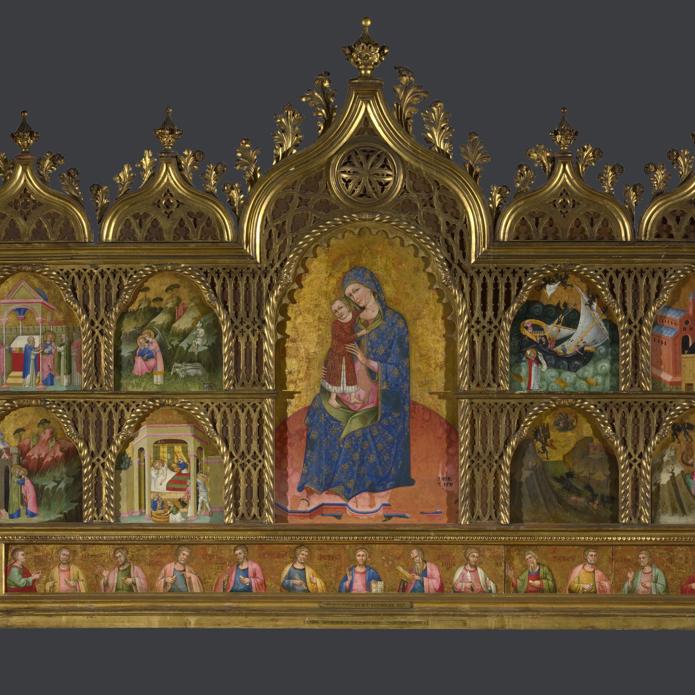Dalmatian/Venetian, 'Saint Joachim and the Angel; The Birth of the Virgin', about 1400
About the work
Overview
The stories on this panel describe the conception of the Virgin Mary by her mother Anne. In the upper part we see a man slouched on the ground: Anne’s husband Joachim. His sacrificial offering was rejected at the temple because of his childlessness, so he fled to the hillsides with his sheep. While there, the Angel of the Lord told him that he and Anne would have a child – we see the angel whispering to him as he sleeps. On the hillside, a shepherd plays a pipe and a dog bares his teeth to keep the flock in check.
The lower scene shows Mary’s birth. Anne lies in a bed, surrounded by attendants who bring her food and prepare for the birth. These details, including the eggs that a man carries into the room in a basket, come from Byzantine versions of the scene.
The moment of the Virgin’s conception is shown in the previous panel, Saint Joachim’s Offering rejected and (below) The Meeting at the Golden Gate.
Key facts
Details
- Full title
- The Angel appearing to Saint Joachim and (below) The Birth of the Virgin
- Artist
- Dalmatian/Venetian
- Part of the group
- Altarpiece of the Virgin Mary
- Date made
- about 1400
- Medium and support
- egg tempera on wood
- Dimensions
- 63.8 × 27.9 cm
- Inscription summary
- Inscribed
- Acquisition credit
- Bequeathed by H.E. Luxmoore, 1927
- Inventory number
- NG4250.3
- Location
- Not on display
- Collection
- Main Collection
- Previous owners
Provenance
Additional information
Text extracted from the ‘Provenance’ section of the catalogue entry in Dillian Gordon, ‘National Gallery Catalogues: The Italian Paintings before 1400’, London 2011; for further information, see the full catalogue entry.
Bibliography
-
1951Davies, Martin, National Gallery Catalogues: The Earlier Italian Schools, London 1951
-
1986Davies, Martin, National Gallery Catalogues: The Earlier Italian Schools, revised edn, London 1986
-
1988Gordon, Dillian, National Gallery Catalogues: The Early Italian Schools before 1400, revised edn, London 1988
-
2001
C. Baker and T. Henry, The National Gallery: Complete Illustrated Catalogue, London 2001
-
2011Gordon, Dillian, National Gallery Catalogues: The Italian Paintings before 1400, London 2011
About this record
If you know more about this painting or have spotted an error, please contact us. Please note that exhibition histories are listed from 2009 onwards. Bibliographies may not be complete; more comprehensive information is available in the National Gallery Library.
Images
About the group: Altarpiece of the Virgin Mary

Overview
This altarpiece is a unique example in the National Gallery’s collection of a work made by a late medieval artist working on both sides of the Adriatic, the sea between Italy and the Balkan coast. The picture may be one of the earliest painted representations of the Virgin of the Immaculate Conception (the Virgin being conceived without sin). This was a controversial idea in this period. It was not officially included in Catholic theology until the nineteenth century, but it was celebrated in the fifteenth century, on 8 December.
The central panel showing the Virgin and Child includes celestial bodies – the sun, moon and stars – that became associated with the Immaculate Conception. The left side panels show the story of the Virgin’s miraculous birth to a couple who could not have children; the right side panels shows two miracles of the Virgin.








